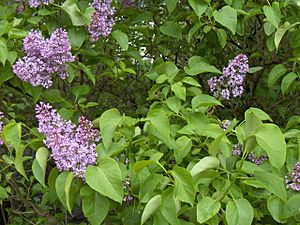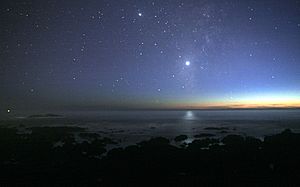When Lilacs Last in the Dooryard Bloom'd facts for kids
| by Walt Whitman | |
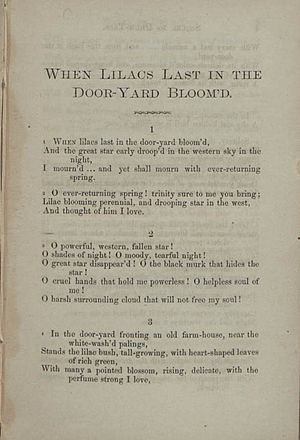
The poem's first page in the 1865 edition of Sequel to Drum-Taps
|
|
| Written | 1865 |
|---|---|
| First published in | Sequel to Drum-Taps (1865) |
| Country | United States |
| Language | English |
| Form | Pastoral elegy |
| Meter | Free verse |
| Publisher | Gibson Brothers (Washington, DC) |
| Publication date | 1865 |
| Lines | 206 |
| Read online | "When Lilacs Last in the Dooryard Bloom'd" at Wikisource |
"When Lilacs Last in the Dooryard Bloom'd" is a long poem written by American poet Walt Whitman (1819–1892). He wrote it as a special poem, called an elegy, to honor President Abraham Lincoln. Whitman wrote the poem in the summer of 1865. This was a time of deep sadness across the United States after President Lincoln was assassinated on April 14, 1865.
The poem is 206 lines long and is written in free verse, which means it doesn't have a strict rhythm or rhyme scheme. It uses many ideas found in a type of mourning poem called a pastoral elegy. Even though it's about Lincoln, Whitman never mentions his name or how he died. Instead, he uses images from nature. These include lilac flowers, a bright star in the western sky (Venus), and a hermit thrush bird.
The poem moves from sadness towards accepting death. It also talks about the sadness of war, hinting at the American Civil War (1861–1865). This war had just ended days before Lincoln's death.
Whitman wrote this poem ten years after his first book, Leaves of Grass (1855). "When Lilacs Last in the Dooryard Bloom'd" shows how Whitman's writing had grown. His earlier poems were full of excitement, but his experiences during the Civil War made his later work more thoughtful. This poem was added to a collection of his war poems called Drum-Taps and Sequel to Drum-Taps. It was first published in autumn 1865 and later became part of Leaves of Grass starting in 1867.
This poem is one of several that Whitman wrote about Lincoln's death. Even though Whitman didn't think it was his best work, many people compare it to famous elegies like John Milton's Lycidas (1637) and Percy Bysshe Shelley's Adonais (1821).
Contents
How the Poem Was Written
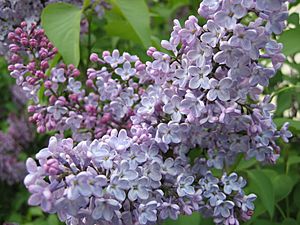
In the late 1850s and early 1860s, Whitman became known as a poet with his book Leaves of Grass. He wanted to write a unique American epic poem. He created a free verse style inspired by the rhythms of the King James Bible. His first book, published in 1855, was seen as controversial by some. However, it was praised by American writer Ralph Waldo Emerson, which helped make Whitman's work popular.
When the American Civil War began, Whitman moved to Washington, D.C. He worked for the government and volunteered in army hospitals. His experiences during the war deeply influenced his poetry. His poems began to explore themes of death, the harshness of war, and patriotism. They showed vivid pictures of wartime life. Whitman's brother, George, was captured in 1864 and held in a prison camp for five months. In February 1865, George was allowed to go home because he was sick. Walt Whitman traveled to his mother's home in New York to visit him. While there, Whitman arranged to publish his Civil War poems, Drum-Taps.
The Civil War ended, and just days later, on April 14, 1865, President Abraham Lincoln was shot by John Wilkes Booth at Ford's Theatre. Lincoln died the next morning. Whitman was at his mother's house when he heard the news. In his sadness, he stepped outside into the yard, where the lilacs were blooming. Years later, Whitman remembered that day in his writings:
I remember where I was stopping at the time, the season being advanced, there were many lilacs in full bloom. By one of those caprices that enter and give tinge to events without being at all a part of them, I find myself always reminded of great tragedy of that day by the sight and odor of these blossoms. It never fails.
Lincoln was the first American president to be assassinated. His death had a lasting impact on the country. For three weeks, millions of Americans mourned him. There was a state funeral and a long funeral train journey that traveled 1,700 miles from Washington to Springfield, Illinois.
Historians believe Whitman may not have attended Lincoln's public funeral in Washington. He left Brooklyn for Washington on April 21, after the funeral on April 19. He also missed the ceremonies in New York on April 24. However, Whitman's descriptions of the funeral procession might have come from what he heard or saw. He may have even passed Lincoln's funeral train on his way to Washington.
Whitman might have remembered the lilacs from his childhood home, the Walt Whitman Birthplace State Historic Site. Lilacs still bloom in the yard there today.
How the Poem Was Published
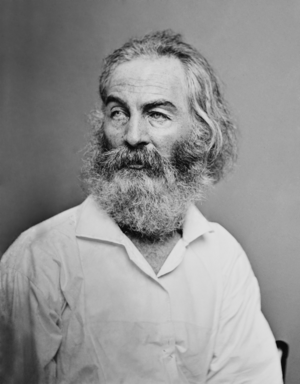
On April 1, 1865, Whitman signed a deal to publish Drum-Taps, a collection of 43 poems about the Civil War. This book was being printed when Lincoln was assassinated two weeks later. When Whitman heard the news, he quickly added a new poem, "Hush'd Be the Camps To-Day", to the collection. But Whitman wasn't fully happy with this poem and decided to write a more fitting one for Lincoln.
After returning to Washington, Whitman arranged to publish a small book of eighteen poems. This included two poems directly about the assassination: "When Lilacs Last in the Dooryard Bloom'd" and "O Captain! My Captain!". This 24-page collection was called Sequel to Drum-Taps. The poem "When Lilacs Last in the Dooryard Bloom'd" took up the first nine pages. In October, he had these new poems combined with Drum-Taps.
Whitman later added all the poems from Drum-Taps and Sequel to Drum-Taps to the fourth edition of his famous book, Leaves of Grass, in 1867. Whitman kept changing and adding to Leaves of Grass throughout his life. The first edition in 1855 had only twelve poems. By the time he died, it had about 400 poems. "When Lilacs Last in the Dooryard Bloom'd" is one of several poems from Leaves of Grass that are often found in poetry books today.
Main Ideas and Symbols
A Trinity of Symbols: Lilac, Star, and Bird
Whitman's poem uses three main symbols. A biographer named David S. Reynolds calls them a "trinity" of symbols. They are also linked to Whitman's own life:
- The lilacs stand for the poet's lasting love for Lincoln.
- The fallen star (Venus) represents Lincoln.
- The hermit thrush bird represents death or its song.
The Lilac: A Blooming Flower
When Whitman saw the lilacs blooming in his mother's yard, the flowers became strongly connected to the memory of Lincoln's death for him.
The lilacs can mean many things in the poem. They can represent love, spring, life, and the natural world. They can also symbolize new beginnings or comfort. They might even represent a father figure or the cause of the poet's sadness.
The Star: A Great Light Falling
Before Lincoln was assassinated, Whitman saw the planet Venus shining brightly in the evening sky. He later wrote that the star seemed to be telling something important to Americans. In the poem, Whitman describes the star disappearing:
O powerful, western, fallen star!
O shades of night! O moody, tearful night!
O great star disappear'd! O the black murk that hides the star! (lines 7–9)
Literary experts say the falling star represents Lincoln. It also shows the strong, mixed feelings the poet had. The star can also represent America itself, and Lincoln's vision for a united country. This vision could only continue if Americans kept working for it after his death.
The Bird: A Shy Singer
In the summer of 1865, Whitman's friend, John Burroughs, a nature writer, told him about the hermit thrush. Burroughs described its song as "the finest sound in nature." He said it was a calm, sweet, and serious song. Whitman took many notes about the bird. He wrote that it "sings oftener after sundown...is very secluded...likes shaded, dark places...His song is a hymn...in swamps—is very shy...never sings near the farm houses—never in the settlement—is the bird of the solemn primal woods & of Nature pure and holy."
Whitman's notes connect to these lines in the poem:
In the swamp in secluded recesses,
A shy and hidden bird is warbling a song.
Solitary the thrush
The hermit withdrawn to himself, avoiding the settlements,
Sings by himself a song. (lines 18–22)
The hermit thrush is often seen as a symbol for Whitman himself in the poem. Its song is the source of the poet's understanding. The bird helps Whitman come to terms with Lincoln's death and with death in general. It sings a "joyful carol of death," helping the poet find peace.
The Poem's Lasting Impact
Influence on T. S. Eliot
Many scholars believe that poet T. S. Eliot (1888–1965) was inspired by Whitman's elegy when he wrote his famous poem The Waste Land (1922). Eliot's poem starts by mentioning lilacs and April. It also has lines about "dry grass singing" and "where the hermit-thrush sings in the pine trees." Eliot himself said that these lines, inspired by Whitman, were the only "good lines" in his poem.
Some experts suggest that Eliot's poem, like Whitman's, might also be a poem of mourning for a close friend. Eliot spent time with a French medical student named Jean Jules Verdenal in Paris. Verdenal died in 1915 during a war. Eliot remembered Verdenal "coming across the Luxembourg Garden in the late afternoon, waving a branch of lilacs." This memory might have influenced Eliot's use of lilacs in his own poem.
Musical Interpretations
Many composers have set Whitman's poetry to music. Some critics have called his writing "unmusical," but others note that his long, flowing style and repetition are like music.
Holst
After World War I, composer Gustav Holst used the last part of Whitman's elegy to mourn friends who died in the war. He wrote his piece Ode to Death (1919) for a choir and orchestra. Holst saw Whitman as a leader for peace and understanding between countries.
Hartmann
In 1936, German composer Karl Amadeus Hartmann (1905–1963) began setting a German translation of Whitman's poem to music. He later used this music as part of his First Symphony. Hartmann kept his music from being performed in Germany during the Nazi era. His first symphony is seen as a protest against the Nazi government.
Hindemith
American conductor Robert Shaw asked German composer Paul Hindemith to set Whitman's poem to music. This was to mourn the death of President Franklin D. Roosevelt in 1945. Hindemith's work was called When Lilacs Last in the Dooryard Bloom'd: A Requiem for those we love. It premiered in 1946. Many people consider it Hindemith's most "American" work.
Weill, Hughes, and Rice
Whitman's poem also appears in the Broadway musical Street Scene (1946). This musical was a team effort by composer Kurt Weill, poet Langston Hughes, and playwright Elmer Rice. In the play, a part of the poem is recited, followed by a song called "Don't Forget The Lilac Bush," which was inspired by Whitman's words.
Modern Settings
In 1996, African-American composer George T. Walker, Jr. (1922–2018) won the Pulitzer Prize for Music for his piece Lilacs for voice and orchestra, which used Whitman's poem.
Composer George Crumb (born 1929) also set the "Death Carol" section of the poem to music in his 1979 work Apparition.
The University of California, Berkeley asked composer Roger Sessions (1896–1985) to set the poem to music in 1964. Sessions finished the work in the 1970s, dedicating it to the memories of Civil Rights movement leader Martin Luther King Jr. and political figure Robert F. Kennedy, who were both assassinated in 1968.
In 2004, American composer Jennifer Higdon adapted the poem for a piece called Dooryard Bloom, for a solo singer and orchestra. It was first performed in 2005.
Steve Dobrogosz also set the poem to music, releasing a CD of his work in 2006.


